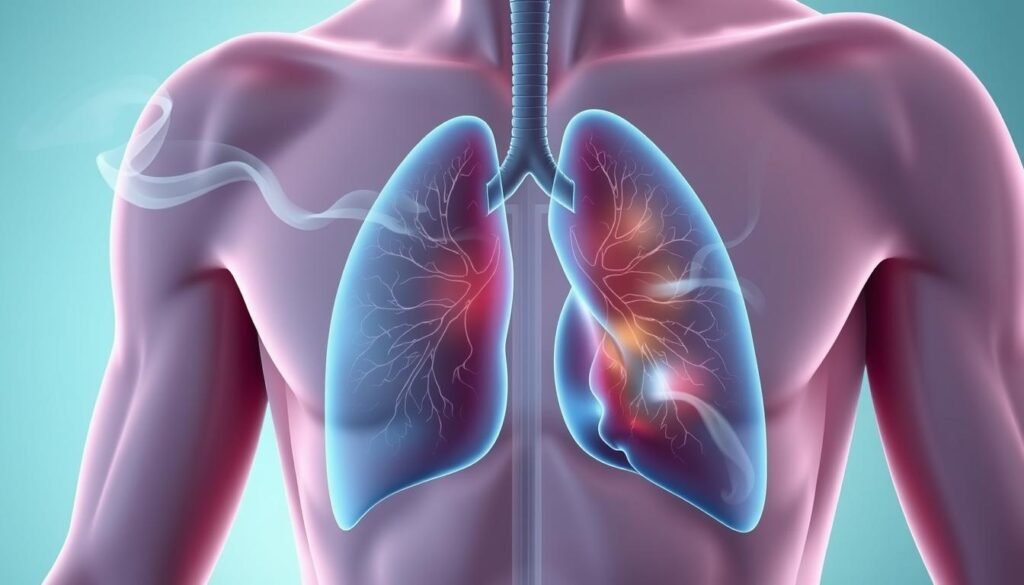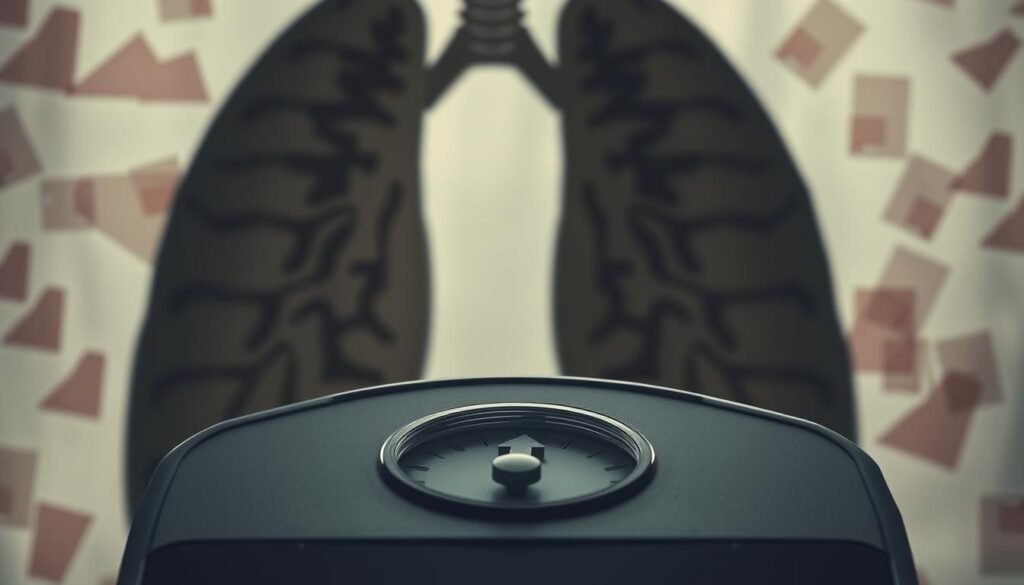More than 70% of lung cancer patients see no symptoms early on. That’s why catching lung cancer early is key. Right lower lobe lung cancer can be silent, but noticing the first signs helps greatly. Among these signs are a lasting cough, chest pain, and weight loss without trying. These symptoms might seem minor but are critical for early action. Knowing them helps in getting to a doctor fast.
Key Takeaways
- Early recognition of right lower lobe lung cancer symptoms can lead to improved treatment options.
- Most lung cancers do not show symptoms until advanced stages.
- Common symptoms include persistent cough, chest pain, and unexplained weight loss.
- Consulting healthcare providers promptly can be life-saving.
- Misinterpretation of symptoms is common, highlighting the need for awareness.
Overview of Lung Cancer
Lung cancer leads in causing cancer-related deaths across the globe. It develops from abnormal cell growth in the lungs. Often, smoking, secondhand smoke, and harmful environmental elements play big roles. Learning about lung cancer overview is crucial. It helps understand the risks and how to prevent them.
Non-small cell lung cancer (NSCLC) and small cell lung cancer (SCLC) are the main types. NSCLC is more common and includes different forms like squamous cell carcinoma. SCLC is mainly seen in heavy smokers. The more cigarettes you smoke, the higher your risk of lung cancer.
Family history also affects lung cancer risk. If your parents or siblings had it, you’re more likely to get it too. Radon, a gas from uranium breakdown in soil and water, is dangerous. But, high levels in homes can often be reduced to make them safer.
Being around harmful substances at work can increase lung cancer risk. Wearing protection and following safety rules can lower the harm. Sadly, lung cancer often isn’t found until it’s very advanced. This makes awareness and regular doctor visits key. Treatments depend on the cancer type and stage and can include surgery and chemotherapy. They aim to lessen symptoms and help people live better lives.
For more details on treatments, check out treatments for lung cancer.
Lung Cancer: An Introduction
Lung cancer causes more deaths than many other cancers combined. It usually starts in the lungs, making breathing hard. What is lung cancer? It’s uncontrolled cell growth in lung tissue. Knowing about it is key for early detection and treatment.
Smoking is the main cause of lung cancer, linked to about 90% of cases. Even though it’s rare in people under 45, environmental toxins also increase the risk. Things like air pollution, arsenic in water, and exposure to asbestos or radon are dangerous too.
Often, lung cancer doesn’t show symptoms at first. This makes early detection methods crucial. For detailed information on diagnosing and treating lung cancer, check out this source.
| Key Facts about Lung Cancer | Statistics |
|---|---|
| Percentage caused by smoking | 90% |
| Small cell lung cancer cases | 20% |
| Common diagnostic tests | Bone scan, chest x-ray, CT scan, PET scan, biopsies |
| Age risk factor | Rare under 45 |
Understanding the Right Lower Lobe
The right lower lobe is an important part of the lung. It’s one of three lobes in the right lung. It’s filled with small structures like bronchioles and alveoli that are key for breathing. This lobe plays a big role in exchanging gases we breathe in and out. It’s also where tumors can form, especially in lung cancer cases.
This lobe helps us take in oxygen and get rid of carbon dioxide. It’s crucial for keeping our breathing healthy. Knowing about this lobe can help us spot early signs of lung issues. This can lead to faster diagnosis and treatment for lung cancer.
| Structure | Function |
|---|---|
| Bronchioles | Conduct air to alveoli for gas exchange |
| Alveoli | Facilitate oxygen and carbon dioxide exchange |
| Capillaries | Distribute oxygen to blood and remove carbon dioxide |
Understanding the right lower lobe’s role is key. It helps us spot health problems early on. This knowledge is very important for learning about lung health.
Right Lower Lobe Lung Cancer Symptoms
Knowing the signs of right lower lobe lung cancer early is key. At first, the symptoms may be hard to spot. But as the cancer grows, symptoms get clearer. Spotting these signs early is crucial for starting treatment early.
Common Symptoms to Watch For
Look out for specific right lower lobe lung cancer symptoms needing quick doctor visits. These include:
- Persistent cough that may produce blood-tinged sputum
- Chest pain, especially when taking deep breaths
- Shortness of breath or difficulty breathing
- Back pain or chest discomfort
- Severe headaches if the cancer has spread
- Fatigue and unexplained weight loss
These are signs of common lung cancer signs. They might seem like asthma or allergies at first. Knowing them helps get early medical advice.
Importance of Early Detection
Early detection of lung cancer is very important. Research shows finding it early greatly improves chances of treatment working. This means patients diagnosed early have more options. And they have better forecasts.
Late-stage diagnoses often limit treatment choices and outcomes. Doctors use tests like imaging and biopsies to understand the disease better. This way, they can start the best treatment quickly.

Common Lung Cancer Signs
Spotting lung cancer signs early can lead to prompt treatment. A constant cough and pain in the chest are key signs. They deserve immediate attention for better health outcomes.
Persistent Cough
The start of lung cancer might show as a cough. What begins as ordinary, could turn persistent. A cough with blood or rust-colored spit signals a big worry. It’s key for early spotting and getting medical advice.
Chest Pain
Pain in the chest points to lung cancer. It gets worse when you cough, laugh, or breathe deep. Knowing this helps in taking the right steps for your health. Paying attention to these signs leads to proactive health actions.
| Common Lung Cancer Signs | Description |
|---|---|
| Persistent Cough | A chronic cough that may produce blood or rust-colored sputum. |
| Chest Pain | Discomfort in the chest that worsens with coughing, laughing, or deep breaths. |
Other Respiratory Issues Related to Lung Cancer
As lung cancer gets worse, people often see big changes in how they breathe. Shortness of breath and wheezing are two main symptoms that need quick action. These problems can happen because of different issues caused by the cancer.
Shortness of Breath
Shortness of breath is a common problem that shows up as lung cancer gets worse. This can happen when the tumor blocks the airways or when fluid builds up around the lungs. This is also known as pleural effusion. Activities that were once easy can become hard as it gets tough to breathe. Finding out why this is happening is key to helping and making life better.
Wheezing
Wheezing is another key sign that breathing is getting harder for people with lung cancer. This sound happens when air squeezes through tight airways. There are many reasons why this might happen because of the cancer. It’s very important for people to tell their doctors if they wheeze. This way, they can get help quickly if there are serious problems.
| Symptom | Description | Potential Causes |
|---|---|---|
| Shortness of Breath | Difficulty in breathing that may worsen over time. | Tumor obstruction, pleural effusion. |
| Wheezing | High-pitched sound produced during breathing. | Narrowed airways, inflammation. |
Knowing about these breathing problems is crucial for getting help fast. It’s important for both patients and those taking care of them to watch for any changes in how they breathe.
Hemoptysis: Coughing Up Blood
Hemoptysis means coughing up blood. It’s a big warning sign of lung cancer. Never ignore it, as it could point to serious health problems. People often see blood in their spit. The amount of blood can tell us how severe the hemoptysis is. It’s classified from mild to massive.
Coughing up blood isn’t just linked to lung cancer. It can also come from COPD, pneumonia, and tuberculosis. These conditions show why a full medical check-up is necessary when you cough up blood. Seeing a doctor early helps find out the cause and start the right treatment.
Hemoptysis can happen because of cancer for a few reasons. Tumors can make new blood vessels, erode tissue, or react to treatments. It’s urgent to get medical help. Many lung cancer patients have coughed up blood. It happens in 5% to 15% of cancer cases. Doctors use chest X-rays and CT scans to look into it further.
How doctors treat hemoptysis depends on how bad it is. In severe cases, quick action is needed. For milder cases, doctors work on fixing the root cause. Catching the problem early is key. Only 23% of lung cancer gets found early. Early diagnosis means a much better chance of survival.
If you’re coughing up blood, see a doctor right away. This step is crucial for your health. Knowing what hemoptysis means is important in handling lung cancer. It can really help improve your chances. To learn more about hemoptysis and lung cancer, check out this link.
Unexplained Weight Loss as a Warning Sign
Unexplained weight loss is a big warning sign for serious health issues, like lung cancer. It happens when someone loses more than 5% of their weight in 6 to 12 months without trying. This is common in lung cancer patients, affecting 35% to 75% of them. It’s important to understand what this weight loss means to catch the disease early.
Understanding Unintentional Weight Loss
Unexpected weight loss can happen for several reasons in lung cancer patients. The body uses more energy to fight the disease, leading to less appetite and weight loss. This can show the cancer is getting worse but also how the body fights back. Knowing why this happens is key for both patients and doctors.
Possible Implications for Lung Cancer
Weight loss is a big deal when it comes to lung cancer. It can be an early sign of the disease and affect how well treatments work. Losing a lot of weight before finding out you have lung cancer usually means the cancer is advanced. Recognizing weight loss, along with symptoms like a long-lasting cough or coughing up blood, can really help in starting treatment early.

| Weight Loss Category | Definition | Percentage of Lung Cancer Patients |
|---|---|---|
| Unintentional Weight Loss | Loss of 5% of body weight or more over 6 to 12 months | 35% – 75% |
| Significant Weight Loss | Loss of over 10 pounds without trying | Varies by individual |
Knowing about unexplained weight loss as a major symptom helps with early cancer detection. When people notice these changes, they should see a doctor. This is crucial in fighting lung cancer and finding better treatments.
When Symptoms Indicate Advanced Cancer
Recognizing symptoms of advanced lung cancer is very important for good care. People may face different signs that show the cancer is getting worse. Some people feel more pain and might notice changes in how their body works.
Increased Pain and Discomfort
As lung cancer gets worse, the pain can spread to different parts of the body. This pain is a clear sign that the cancer is progressing. It might start from the tumor itself or from cancer moving to the bones. Anyone feeling constant pain should talk to their doctors about ways to manage it.
Neurological Changes
If lung cancer reaches the brain or impacts the nervous system, it can lead to serious changes. These include headaches, feeling dizzy, and not being able to feel certain parts of the body. These signs are urgent and mean you need to see a doctor quickly. Finding out the cause early is key to getting the right treatment.
Importance of Consulting a Healthcare Provider
Noticing signs of lung cancer can seem scary. It’s crucial to see a healthcare provider if you have symptoms. Acting quickly can lead to an early diagnosis. This can greatly improve the chances of successful treatment. It’s very important to catch lung cancer early.
Teaching people about lung cancer is extremely important. It helps everyone know what to look out for. People who might get lung cancer should get checked often. The U.S. Preventive Services Task Force recommends yearly checks for some adults. This can find lung cancer early, when it’s easier to treat.
- Contact the LUNGevity Lung Cancer Helpline at 844-360-LUNG (5864) for more information.
- If financial assistance is required, CancerCare offers support for eligible families to help manage treatment costs.
- Free support groups led by oncology social workers are available through CancerCare, providing necessary emotional and social support.

Conclusion
It’s key to know how important lung cancer awareness is. Spotting early signs like a persistent cough, chest pain, and unexplained weight loss can save lives. Early detection is vital in fighting lung cancer. People, especially smokers or those around toxins, should watch for these signs and get checked right away.
Lung cancer is the third most common cancer in the US, leading in cancer deaths. Knowing the symptoms and risks can greatly improve outcomes. For tips on early detection, visit this site.
There are effective treatments like surgery and new therapies. Catching lung cancer early is crucial for survival. Being informed and seeking help early can greatly better people’s health futures.